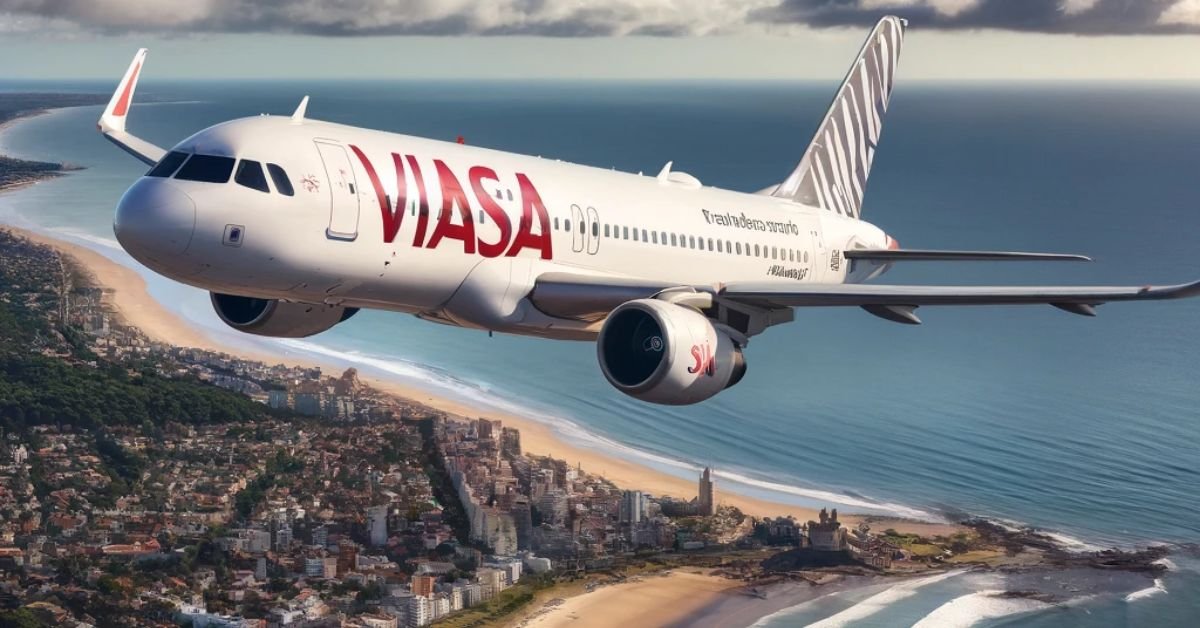Founded in 1960, Viasa (Venezolana Internacional de Aviación, Sociedad Anónima) quickly established itself as Venezuela’s flagship carrier. Initially created through a partnership between the Venezuelan government and private investors, Viasa aimed to become the leading airline in Latin America. During its early years, the airline focused on regional flights, connecting Venezuela to neighboring countries. However, with strategic vision and ambition, Viasa expanded its horizons, adding more international destinations to its route network.
Founding and Early Years
Viasa was born from the necessity of having a national airline that could represent Venezuela on the global stage. The airline commenced operations with a fleet of Douglas DC-6 aircraft, which were well-suited for both short and medium-haul flights. The initial routes primarily connected major Venezuelan cities with other key destinations in Latin America. This period was marked by steady growth, driven by the burgeoning demand for air travel in the region.
Key Milestones
Throughout the 1960s and 70s, Viasa achieved several significant milestones. The acquisition of jet aircraft like the Convair 880 and the Douglas DC-8 allowed the airline to operate long-haul flights. This period saw the introduction of routes to Europe, including destinations such as Madrid, Paris, and Rome. These expansions not only increased Viasa’s visibility but also solidified its reputation as a reliable international carrier.
Expansion and Growth
By the 1980s, Viasa had firmly established itself as a key player in the aviation industry. The airline’s fleet modernization efforts included the addition of Boeing 727 and McDonnell Douglas DC-10 aircraft, which offered improved performance and greater passenger capacity. Viasa’s network extended to North America, including cities like New York and Miami, further enhancing its international presence.
Challenges and Downfall
Despite its successes, Viasa faced numerous challenges in the 1990s. Economic instability in Venezuela, coupled with increasing competition from other airlines, put financial pressure on the carrier. Mismanagement and operational inefficiencies exacerbated these issues, leading to mounting debts. In 1997, after a series of unsuccessful attempts to restructure and revitalize the airline, Viasa ceased operations, marking the end of an era.
Also Read: 5612425780 | The Enigmatic Escórpio
Viasa’s International Routes
The breadth of Viasa’s international routes was a testament to its ambition and strategic planning. The airline connected Venezuela with over 25 countries, offering flights to major cities across Latin America, North America, and Europe. This extensive network not only facilitated international travel for Venezuelans but also positioned Venezuela as a transit hub in the region.
Popular Destinations
Some of the most popular destinations in Viasa’s network included Miami, Madrid, New York, Paris, and Rome. These cities were critical for business and tourism, making them vital links in Viasa’s route map. The airline’s ability to consistently operate flights to these high-demand destinations underscored its reliability and service quality.
Key Partnerships
Viasa’s success was partly due to its strategic partnerships with other airlines. These alliances allowed Viasa to expand its reach without the need for extensive investments in new routes. Codeshare agreements and interline partnerships enabled seamless travel for passengers, enhancing the overall travel experience and operational efficiency.
Route Network Evolution
Over the years, Viasa’s route network evolved in response to changing market demands and economic conditions. The airline continually assessed and adjusted its routes to optimize performance and meet passenger needs. This dynamic approach helped Viasa maintain relevance in a competitive industry, even as external pressures mounted.
Significance of Uruguay as a Destination
Uruguay, a small yet vibrant country in South America, played a significant role in Viasa’s route network. The inclusion of Uruguay as a destination was not merely a business decision; it reflected deeper economic, cultural, and strategic considerations.
Economic Impact
Flights between Venezuela and Uruguay facilitated trade and investment, fostering stronger economic ties between the two nations. Viasa’s operations contributed to the growth of the tourism sector in Uruguay, bringing in visitors and boosting local economies. The airline also provided critical connectivity for business travelers, enabling smoother and more efficient commercial exchanges.
Tourism and Travel
Uruguay’s appeal as a travel destination lay in its rich cultural heritage, picturesque landscapes, and vibrant cities like Montevideo. Viasa’s flights made it easier for tourists to explore Uruguay’s unique attractions, from its historic colonial architecture to its pristine beaches. This accessibility helped position Uruguay as a desirable destination for international travelers.
Strategic Importance
Geopolitically, Uruguay served as a crucial link in Viasa’s South American network. Its strategic location allowed Viasa to efficiently connect different parts of the continent, optimizing route logistics and enhancing service offerings. This connectivity was instrumental in maintaining Viasa’s competitive edge in the region.
Viasa Volava a Uruguay
The route connecting Venezuela and Uruguay was one of Viasa’s significant achievements. This service highlighted the airline’s commitment to providing comprehensive connectivity across Latin America, serving both passenger and cargo needs.
Inception of the Route
The inception of the Viasa Volava a Uruguay route marked a pivotal moment in the airline’s expansion strategy. Launched in the late 1960s, the route quickly gained popularity among travelers seeking direct flights between the two countries. The decision to include Uruguay in Viasa’s network was driven by market demand and the airline’s broader vision of connecting Latin America.
Operational Highlights
Operating the Uruguay route required meticulous planning and execution. Viasa deployed some of its most advanced aircraft on this route, ensuring a comfortable and reliable journey for passengers. The airline’s commitment to punctuality and service excellence was particularly evident on this route, making it a preferred choice for many.
Passenger Experiences
Passengers on Viasa’s Uruguay flights often praised the airline for its high standards of service. From efficient check-in processes to the comfort of in-flight amenities, Viasa consistently delivered a positive travel experience. Personal anecdotes and testimonials from passengers highlighted the airline’s dedication to customer satisfaction.
Passenger Services on Viasa Flights
Viasa was renowned for its exceptional passenger services, which were designed to ensure a pleasant and memorable travel experience. The airline’s focus on quality and customer satisfaction set it apart in the competitive aviation industry.
In-flight Experience
The in-flight experience on Viasa flights was characterized by comfort and convenience. Passengers enjoyed spacious seating, modern entertainment systems, and attentive service from the cabin crew. Viasa prioritized passenger well-being, offering amenities that catered to both leisure and business travelers.
Catering Services
Catering was a standout aspect of Viasa’s service offering. The airline provided a variety of meal options, reflecting both local Venezuelan cuisine and international flavors. Special dietary requirements were accommodated with ease, ensuring that all passengers could enjoy their meals during the flight.
Customer Service Excellence
Viasa’s commitment to customer service was evident at every touchpoint. From the booking process to post-flight support, the airline strived to exceed passenger expectations. Customer feedback was actively sought and used to improve services, fostering a culture of continuous improvement and excellence.
Aircraft Used by Viasa
Viasa’s fleet was a key component of its operational success. The airline invested in modern and efficient aircraft, which contributed to its reputation for safety and reliability.
Fleet Overview
Viasa operated a diverse fleet that included both narrow-body and wide-body aircraft. This diversity allowed the airline to tailor its services to different routes and passenger needs. Key aircraft in the fleet included the Douglas DC-6, Convair 880, Boeing 727, and McDonnell Douglas DC-10.
Technological Innovations
Viasa was an early adopter of technological innovations in aviation. The airline invested in advanced navigation systems, fuel-efficient engines, and state-of-the-art safety features. These innovations not only enhanced operational efficiency but also improved the overall passenger experience.
Safety Standards
Safety was a paramount concern for Viasa. The airline adhered to stringent safety standards and protocols, ensuring that all flights were conducted with the highest levels of safety and security. Regular maintenance checks and crew training programs underscored Viasa’s commitment to safety.
Competition in the Airline Industry
The competitive landscape of the airline industry posed both challenges and opportunities for Viasa. The airline’s ability to navigate this environment was crucial to its success.
Competitors
Viasa faced competition from both regional and international airlines. Competitors like Aerolíneas Argentinas, Avianca, and Varig were prominent players in the Latin American market. These airlines offered similar routes and services, compelling Viasa to continuously innovate and improve.
Market Position
Despite the competition, Viasa managed to carve out a strong market position. Its focus on quality service, extensive route network, and strategic partnerships helped it maintain a competitive edge. Viasa’s reputation for reliability and customer satisfaction also contributed to its market standing.
Strategic Responses
To stay ahead of competitors, Viasa implemented several strategic initiatives. These included fleet modernization, route optimization, and marketing campaigns aimed at building brand loyalty. The airline also explored new markets and partnerships, seeking to diversify its revenue streams and reduce dependence on any single route or region.
The Decline of Viasa
The decline of Viasa was a complex process, influenced by multiple internal and external factors. Understanding these factors provides insights into the challenges faced by the airline.
Financial Troubles
Financial difficulties were a significant factor in Viasa’s decline. The airline struggled with mounting debts, exacerbated by economic instability in Venezuela. Efforts to secure additional funding or restructure existing debts were largely unsuccessful, leading to a downward financial spiral.
Management Decisions
Management decisions also played a role in Viasa’s downfall. Strategic missteps, such as over-expansion and inadequate cost controls, strained the airline’s resources. Leadership changes and governance issues further complicated the situation, reducing the effectiveness of decision-making processes.
Government Interventions
Government interventions, including attempts to nationalize the airline, were unable to reverse its fortunes. While these interventions aimed to stabilize operations and protect jobs, they often led to bureaucratic inefficiencies and additional financial burdens. Ultimately, the combination of financial woes, management challenges, and government interventions culminated in Viasa ceasing operations in 1997.
Uruguay’s Aviation Landscape Post-Viasa
The closure of Viasa created a vacuum in the aviation market, prompting new developments in Uruguay’s aviation landscape. The emergence of new airlines and changes in market dynamics have shaped the current state of the industry.
New Entrants
Following Viasa’s exit, new airlines entered the market, seeking to capitalize on the available opportunities. Carriers like LATAM, Copa Airlines, and Avianca have established a strong presence in Uruguay, offering a range of domestic and international flights.
Current Market Dynamics
The current aviation market in Uruguay is characterized by increased competition and improved services. Airlines have focused on enhancing passenger experiences, expanding route networks, and investing in modern aircraft. These efforts have contributed to a more vibrant and competitive aviation sector.
Future Prospects
The future prospects for Uruguay’s aviation industry are promising. Continued economic growth, coupled with rising demand for air travel, is expected to drive further expansion. Investments in airport infrastructure and technological advancements will also play a crucial role in shaping the industry’s future.
Case Studies: Notable Flights and Events
Examining specific flights and events provides a deeper understanding of Viasa’s impact and legacy. These case studies highlight key moments in the airline’s history.
Memorable Journeys
Certain Viasa flights are remembered for their significance and impact. For example, inaugural flights to new destinations often garnered significant attention and celebration. These journeys represented the airline’s growth and ambition, leaving a lasting impression on passengers and stakeholders.
High-profile Passengers
Viasa frequently transported high-profile passengers, including government officials, celebrities, and business leaders. These flights were often accompanied by heightened media attention and security measures. The presence of such passengers underscored Viasa’s reputation and prestige.
Historical Incidents
Like any airline, Viasa experienced its share of challenges and incidents. These included technical issues, weather-related disruptions, and occasionally more serious events. The airline’s response to these incidents demonstrated its commitment to safety and professionalism.
Cultural Impact of Air Travel
Air travel has had a profound cultural impact, influencing society in various ways. Viasa’s operations contributed to this cultural transformation, connecting people and places.
Influence on Society
The advent of air travel revolutionized the way people perceive distance and time. Viasa’s flights made it possible for individuals to explore new cultures, conduct international business, and maintain personal connections across borders. This connectivity has had a lasting impact on societal norms and behaviors.
Air Travel in Media
Air travel has been a popular theme in media, from movies and television shows to literature and music. Viasa’s presence in popular culture reflected its significance and impact. Stories and depictions of air travel often highlighted the excitement and adventure associated with flying, capturing the imagination of audiences.
Personal Stories
Personal stories of air travel experiences with Viasa are numerous and varied. These narratives often include tales of exploration, reunions, and adventures. The emotional and experiential aspects of air travel create lasting memories and connections, underscoring the cultural significance of aviation.
Environmental Considerations
Environmental considerations have become increasingly important in the aviation industry. Viasa’s approach to environmental sustainability provides insights into the challenges and opportunities in this area.
Viasa’s Environmental Policies
During its operational years, Viasa implemented several environmental policies aimed at reducing its ecological footprint. These included initiatives to improve fuel efficiency, minimize waste, and promote sustainable practices. Viasa’s efforts laid the groundwork for future advancements in aviation sustainability.
Sustainability in Aviation
Sustainability has become a key focus for modern airlines. The industry is exploring various approaches to reduce carbon emissions, such as the use of sustainable aviation fuels, electric aircraft, and improved operational efficiencies. These efforts are crucial in addressing the environmental impact of air travel.
Modern Practices
Today, airlines are adopting a range of practices to enhance environmental sustainability. These include investing in newer, more efficient aircraft, optimizing flight routes, and implementing carbon offset programs. The commitment to sustainability is evident in the industry’s ongoing efforts to balance growth with environmental responsibility.
Conclusion
Viasa’s legacy in the aviation industry is marked by its pioneering spirit, commitment to quality service, and lasting impact on international travel. The airline’s history, from its inception to its eventual decline, offers valuable lessons in the complexities of the aviation industry. Viasa’s flights to Uruguay exemplify the broader significance of air travel in fostering connections, facilitating economic growth, and enhancing cultural exchanges. As the aviation industry continues to evolve, the contributions and experiences of airlines like Viasa will remain a crucial part of its history and development.




